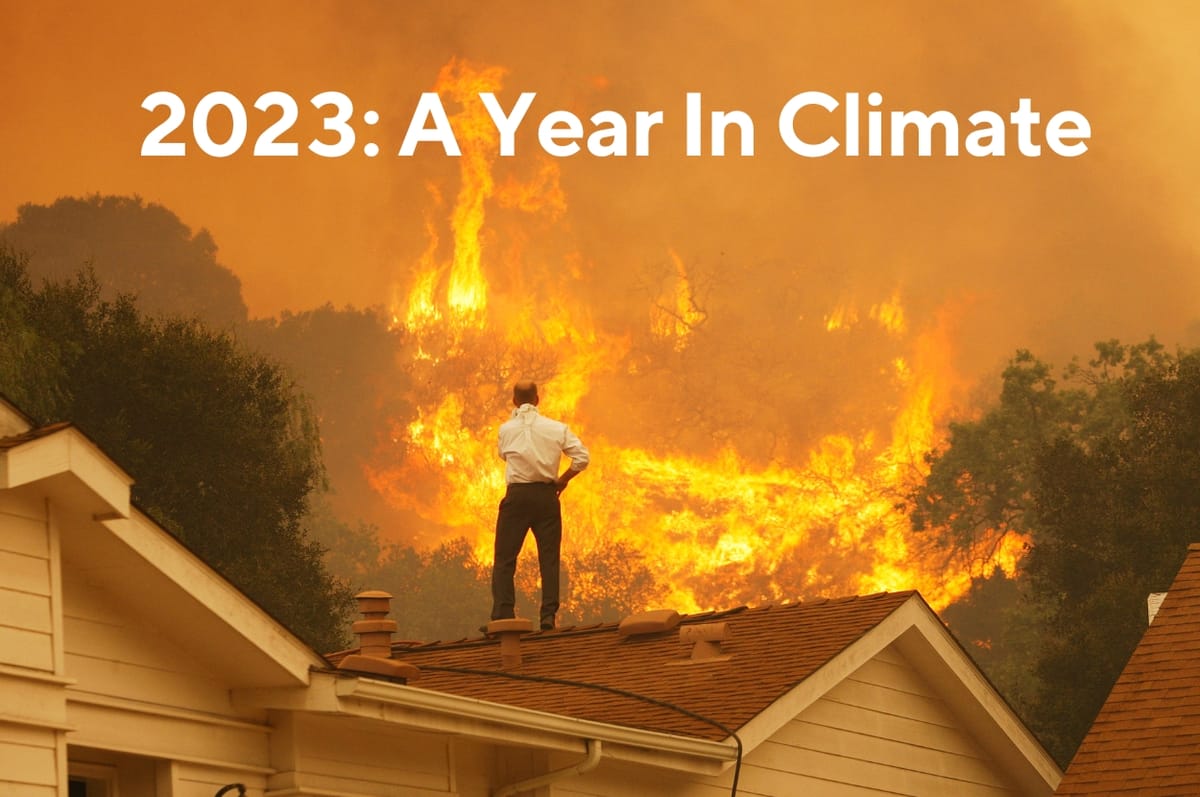2023: A Year In Climate
From Earth’s hottest day ever recorded to devastating floods, the effects of climate change were felt around the world in 2023.

From Earth’s hottest day ever recorded to devastating floods, the effects of climate change were felt around the world in 2023.
But it wasn’t all bad news.
Here are some of the biggest climate stories of this year.
1. As the earth sweltered to its hottest day ever recorded, Canada faced its most severe fire season in history
Canada faced its most severe fire season in history as more than 413 active wildfires, including 249 deemed out of control, raged across the country.
A string of blazes have rapidly spread to almost all Canadian provinces due to the unusually hot and dry weather, with some of the worst cases caused by lightning.
Around 26,000 residents fled from their homes in Quebec and the Eastern Canadian province of Nova Scotia.
The fires triggered health alerts as the smoke has caused poor air quality throughout Canada and has drifted south to as far as New York in the US.
Videos and photos on social media showed New York City shrouded in an orange haze as people walked around wearing masks.
On the evening of Tuesday June 6, New York recorded the worst air quality and pollution in the world, surpassing cities like Delhi in India, Baghdad in Iraq and Dubai, United Arab Emirates, according to IQAir, a Swiss technology company that monitors air quality.
There have already been 2,214 wildfires and about 3.3 hectares scorched in Canada so far this year, which is about 13 times the average from the past 10 years, according to authorities.
In May, hot and dry weather conditions fueled more than 100 wildfires in the western province of Alberta, forcing tens of thousands of people to evacuate their homes.
2. Hawaii’s worst wildfires killed at least 99 people and the before and after looks unreal
Three wildfires ravaged Hawaii’s West Maui starting early August, killing at least 99 people as the desperate search continues.
The death toll was expected to climb further as the rescue team, aided by 20 cadaver dogs, has combed through only 25% of the charred area, making it the deadliest wildfire in more than a century of US history.
The blazes have obliterated over 2,200 structures and 2,100 acres of land, including much of Lahaina, a tourist favorite that was once the capital of the Kingdom of Hawaii.
This catastrophe stands as Hawaii’s most devastating natural disaster since the 1960 tsunami, which took 61 lives.
Lack of water supply also emerged as a strain on rescue operations.
“We ran out of water. We’re on an island, with a limited supply. And that’s what we all talk about all the time, our limited resources,” a local firefighter told NBC News.
3. More than 11,000 people were killed and entire neighborhoods swept to sea in Libya’s most disastrous flood
Catastrophic flooding ravaged Libya and killed at least 5,000 people following torrential downpour caused by Storm Daniel, which struck the country’s East coast on Sunday, Sep. 10.
The staggering death toll, which is expected to rise as search and rescue operations continue, resulted from the collapse of two dams and four bridges, according to the BBC.
Most victims either died from drowning or collapsed structures as ruthless currents engulfed neighborhoods in whole and swept residents into the Mediterranean Sea.
Meanwhile, an estimated 10,000 Libyans are currently missing, according to The International Red Cross.
Neighboring countries such as Turkey and the United Arab Emirates have dispatched rescue teams to assist Libya’s affected zones.
“Libya was not prepared for a catastrophe like that. It has not witnessed that level of catastrophe before. We are admitting there were shortcomings even though this is the first time we face that level of catastrophe,” the head of Libya’s Emergency and Ambulance Authority told local media.
4. New Zealand’s biggest city experienced its worst flooding in modern history and it looks unreal
Auckland, New Zealand’s biggest city, has completely flooded after receiving more than 75% of its annual summer rainfall in just 15 hours.
The torrential rainfall on Friday Jan. 27 led to the worst floods in the city’s modern history and the wettest day ever recorded.
A state of emergency has been declared as bridges were washed away, houses were inundated and thousands of people were left without power.
At least four people have died and thousands have been forced to evacuate their homes.
Photos and videos on social media showed people wading through waist-deep flood waters as rain continued pouring down and items floating down flooded supermarket aisles.
Flights were delayed and canceled as Auckland Airport’s terminal and runway were also severely flooded.
The cleanup costs was expected to exceed $63 million, which is more than the cost of New Zealand’s West Coast flood in 2021.
5. Somalia was hit by its worst flood in 100 years, right after its worst drought in 40 years
Flash floods in Somalia have left almost 100 people dead and more than 700,000 people displaced in what the United Nations has called a “once-in-a-century event”.
Somalia has been lashed with heavy rains since October, which struck right after the country suffered from its worst drought in four decades.
Since 2020, there have been consecutive failed rainy season in Somalia and other countries in the horn of Africa region, leaving millions struggling for food and water and bringing mass hunger, malnutrition and displacement.
Officials said that central and southern Somalia have already received more rain in the first week of November 2023 than a typical Deyr season – the rainy season – which typically lasts from October to December.
The floods, linked to El Niño, have also inundated nearby countries in eastern Africa, including Ethiopia and Kenya nearby, where at least 46 people were killed, Reuters reported.
The intense flooding and torrential rains damaged homes, roads and bridges, with aid groups raising concerns there could be an increase in disease outbreaks.
The UN said the number of people displaced by the floods in Somalia has “nearly doubled in one week” and many people have been left without shelter, water and food supplies.
6. Beijing was hit by its deadliest flooding in a century
Typhoon Doksuri wreaked havoc in Bejing, China, and its neighboring Hebei province, causing devastating flooding.
21 people were confirmed dead and 26 people were missing, according to AP.
Between July 29 and August 2, the Chinese capital’s Meteorological Bureau recorded 744.8 millimeters of rainfall, shattering a 140-year-old record of 609 millimeters set in 1891.
Last year’s total rainfall in Beijing barely reached 500 millimeters.
The torrential downpour destroyed roads, submerged vehicles, caused power outages, and contaminated drinking water, with rivers rising to dangerous levels.
Zhuozhou, a small city southwest of Bejing in Hebei, suffered the worst impact, with nearly one-sixth of its population forced to seek safety elsewhere.
Meanwhile, over 1.2 million people in Hebei were relocated, according to Reuters.
7. But after nearly two decades, countries signed a historic treaty to protect the world’s oceans and marine life.
On Saturday Mar. 4, after two decades in the making, nearly 200 countries agreed to a historic United Nations treaty to protect marine life and biodiversity in international waters, which are called the high seas.
The “High Seas Treaty” agreement aims to protect at least 30% of the world’s oceans by 2030 – known as 30×30 – by setting up protected areas to avoid damage.
The high seas – which cover almost two-thirds of the world’s oceans – have suffered exploitation from overfishing, chemical and plastic pollution, as well as climate change, leading to biodiversity loss.
Currently, only 1.2% of international waters are protected, and only 0.8% are identified as “highly protected”, according to CNN.
8. In a first, countries also agreed to transition away from fossil fuels for the first time
The agreement was announced on Wednesday Dec. 13 at the end of COP28, the UN’s annual climate change conference, in Dubai, UAE, after 2 weeks of negotiations between nearly 200 countries.
This is the first agreement in COP’s history to explicitly state that it is necessary to shift away from fossil fuels, thus recognizing their role as drivers in the climate crisis.
It calls for countries to “transition away” from fossil fuels in a “just, orderly and equitable” manner this decade to reach net zero by 2050.
However, the agreement was a last minute compromise that does not call for “phasing out” fossil fuels, which means stopping the use of coal, gas and oil.
More than 100 countries, from small island countries – which are the most hard hit by the effects of the climate crisis – to Western superpowers including the US, UK and the EU, had all been fighting for the stronger phrase of “phase out”.
9. After these Pacific Islands’ students’ work, the UN asked the world’s top court to examine the link between climate change and human rights.
On Wednesday March 29, the UN passed a resolution calling on the International Court of Justice – or ICJ – to issue a legal opinion on climate change and human rights.
The resolution was spearheaded by the Pacific Island of Vanuatu, after a group of students across the Pacific Islands launched a campaign for an ICJ advisory opinion on climate change.
An advisory opinion is not legally binding like the ICJ’s official rulings, but it does carry a lot of authority and weight.
Activists say it will provide clarity on countries’ legal obligations to respond to climate change and to protect the rights of current and future generations, as well as serve as a reference and tool that people can use to hold their governments accountable for climate action.
10. In a historic referendum, people in Ecuador voted to protect one of the Amazon’s most biodiverse areas by halting oil drilling
In a historic referendum, people in Ecuador have voted to protect one of the Amazon rainforest’s most biodiverse areas by halting oil drilling.
The Yasuni National Park in eastern Ecuador is one of the most ecologically rich places on Earth with a single hectare of land having more insect species than in all of North America and more species of trees and plants than in any other hectare on Earth.
It is also home to the Tagaeri and Taromenane, two Indigenous tribes that live in voluntary isolation from the outside world.
The area also happens to hold Ecuador’s largest reserve of crude oil, which is Ecuador’s most important export.
The oil drilled from the area accounts for about 12% of Ecuador’s daily crude oil output, according to Reuters.
In 2013, a group of a youth climate activist group named YASunidos and Indigenous leaders launched a campaign to keep the oil in the ground.
Almost 10 years after its inception and despite multiple setbacks, a referendum was finally held on Sunday Sep. 12 in conjunction with the presidential elections, passing with almost 59% of votes from the population, effectively banning oil drilling in the area.
11. People in Switzerland voted to drastically cut carbon emissions and reach net zero by 2050
The bill was first proposed in September 2022, after activists and scientists campaigned to save Switzerland’s iconic glaciers, which are melting at an alarming rate.
It was supported by almost all parties except the right-wing Swiss People’s Party (SVP), which argued the law would increase energy prices and become too costly for Swiss people.
The SVP then triggered a referendum against the law.
However, on Sunday June 18, the majority of Swiss people – 59.1% – voted in favor of the Climate and Innovation law.
The new law will speed up cutting carbon dioxide emissions and rolling out renewable energy, in particular solar energy.
The government will also invest two billion Swiss francs or about $2.2 billion US dollars over 10 years to help people and companies transition away from fossil fuels.
12. France banned short domestic flights to cut emissions
The new law, enacted last month, bans domestic short-haul flights that can be replaced by train rides that are less than two and a half hours long.
The initial proposal had been to ban flights that could be replaced by train journeys under four hours, but this was later reduced to 2.5 after some regions and airlines had filed complaints with the European Commission.
Many have called the ban purely symbolic, saying that it took “all that fuss, for not that much.”
However, activists say the ban could have an educational impact by encouraging people to look into other alternatives to flying.
13. And Kenya created a public holiday for people to plant 100 million trees to fight climate change
Kenya’s President William Ruto said that the country has set a goal of planting 15 billion trees by 2032 and will start by planting 100 million trees this year.
Kenya’s Interior Minister announced the holiday a week earlier on X, formerly known as Twitter, writing, “The country shall be expected to plant trees as a patriotic contribution to the national efforts to save our country from the devastating effects of climate change.”
The government provided 150 million seedlings for free on Monday to be planted in designated public areas.
Kenyans were encouraged to plant a minimum of two seedlings each, to meet the aim of 100 million trees.
Kenya’s forest cover decreased from 12% to 6% between 1990 and 2010, according to the United Nations Food and Agriculture Organization (FAO).





